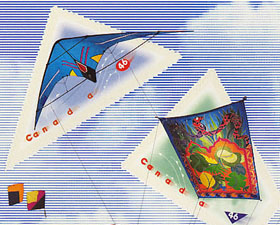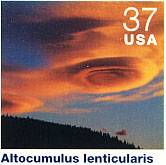
| High-Altitude Kite
Aerial Photography
James S. and Susan W. Aber |
Air density
The force that holds a kite up is determined by wind speed and air density acting on the
lifting surface of the kite. In most situations, wind speed is the deciding factor for
choosing an appropriate kite to carry the camera rig. However, at high altitude the
lower air density also becomes an important factor. Lower air density means there are
fewer or lighter molecules (per air volume) to flow over the kite's lifting surface.
Air density is determined by three factors.
- Pressure -- The weight or force per area exerted by a column of air. Common
pressure units are pounds per square inch (psi), inches of mercury (Hg) or millibars.
Standard atmospheric pressure at sealevel = 29.92 inches of Hg.
- Temperature -- As air is warmed, it expands and thus has a lower density. Hot
air rises, which is what keeps hot-air balloons up, and cold air sinks. Standard atmospheric
temperature at sealevel = 59.0°F.
- Humidity -- Water vapor molecules (H2O) are lighter than are nitrogen
N2 and oxygen O2 molecules that make up most of the atmosphere. Humid
air has a higher proportion of light water molecules than does dry air. The result is that
wet air is lighter than dry air. This humidty effect is fairly small.
The combination of these three factors determines the air density and thus lifting power for
a given wind speed. A good way to understand how air density varies with altitude is with
the standard atmosphere, which is an ideal model of atmospheric conditions. The table
below gives standard values for pressure, temperature and density (ignoring the slight effect
of humidity) at altitudes from sealevel to 16,000 feet (about 4900 m).
Standard Atmospheric Conditions
Altitude
(feet)
| Pressure
(in. Hg)
| Temp.
(F°)
| Density
(%) |
| sealevel
| 29.92
| 59.0
| 100 |
| 2,000
| 27.82
| 51.9
| 94.3 |
| 4,000
| 25.84
| 44.7
| 88.8 |
| 6,000
| 23.98
| 37.6
| 83.6 |
| 8,000
| 22.22
| 30.5
| 78.6 |
| 10,000
| 20.57
| 23.3
| 73.8 |
| 12,000
| 19.02
| 16.2
| 69.3 |
| 14,000
| 17.57
| 9.1
| 65.0 |
| 16,000
| 16.21
| 1.9
| 60.9 |
These values reveal that density decrease is fairly slight up to about one mile (5280 feet)
high, the elevation of Denver, Colorado. At altitudes above 8000 feet (2450 m), however, air
density declines significantly. For example, at 10,000 feet (3060 m) air density is less than
¾ of sealevel density. However, this assumes the "standard" temperature of 23°F at
10,000 feet altitude. What kite flyer wants to work at that temperature in a brisk wind? At higher temperature, say 60°F (15½°C), air density is even less.
The relationship of pressure, temperature, and humidity can be understood in terms of the
density altitude, which is the equivalent "standard altitude" based on actual
conditions at a site. Take the following example, in which pressure is 20½ inches of
mercury (std. at 10,000 feet), humidity is 50%, and temperature is 60°F. The density
altitude is equivalent to about 12,500 feet in the standard atmosphere, which is less than
70% of sealevel air density. To achieve sufficient lift, a very large kite or train of kites
would be necessary to hold up the KAP rig.
 More information on air density.
More information on air density.

| Mountain KAP |
High-altitude kite flying usually means mountains. Mountain ranges often create
strong local weather effects, which include enhanced cloud cover and more precipitation than
for adjacent lowlands. Mountain peaks and valleys are well known for rapid weather changes.
Swirling winds funnel along valleys and over passes with frequent and abrupt changes in
direction. Finding a large enough space for kite flying can be a challenge in forested
mountains, and access to alpine areas above timberline can be quite limited. Areas with good
access are often sites with other human structures and activities that could prove dangerous
for kite flying. Highways, buildings and power lines follow the valleys. Towers, ski lifts
and cable cars may occupy the higher slopes and mountain peaks. The combination of cloud cover,
fickle wind, and limited access makes for difficult kite aerial photography in many mountain
settings.
Culebra Range, Sangre de Cristo Mountains
The Culebra Range of the Sangre de Cristo Mountains forms the "front range" of the Rocky
Mountains in south-central Colorado. Mountain peaks exceed 13,000 feet (4000 m). Parts
of the Culebra Range and adjacent Spanish Peaks
are contained within the San Isabel National Forest--see
map. The forest includes dense growth
of pine, fir, spruce, and aspen. Timberline is around 11,600 to 12,000 feet in the Culebra
Range, although some lower parts have been logged or cleared for development. Wind gusts
more than 100 mph (160 km/h) occur often. Major tourist attractions in the vicinity include
Cuchara Mountain Resort and Monument Lake.
The following kite aerial photographs were taken in vicinity of Cuchara, Colorado in June
1999. The single-camera, radio-controlled KAP rig was utilized with Kodak Elite 200
color-slide film. All photographs © J.S. Aber.

| View over Blue Lakes campground with Trinchera Peak
(13,517 feet) in the center background. Dark trees are mainly blue spruce and lighter trees
are aspen. Ground elevation of kite flyers about 10,400 feet. Flying the KAP rig in this
narrow valley proved to be quite tricky. |

| View toward the Culebra Range from Cucharas Pass.
Blue/Bear Lakes campground is located at extreme left edge of view (up the red-colored
valley), and Cuchara Mountain Resort is in the right background. Ground elevation of kite
flyers about 10,000 feet. |

| Cuchara Mountain Resort base area and ski runs. The
crest of the Culebra Range can be seen in the right background. Ground elevation of kite
flyers about 9200 feet. Large parking area for the ski resort was a good site for flying
the KAP rig. |

| View eastward from Cuchara Mountain Resort. The top
of West Spanish Peak (13,626 feet) is visible on the far horizon. The light-colored, rocky
ridge in front of West Spanish Peak is granite outcrop of White Peaks. Ground elevation of
kite flyers about 9200 feet. |
 Related websites
Related websites
Return to KAP weather conditions or KAP
homepage.
Last update: Jan. 2005, © J.S. Aber.

